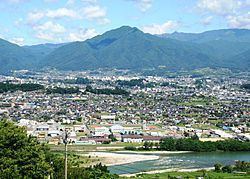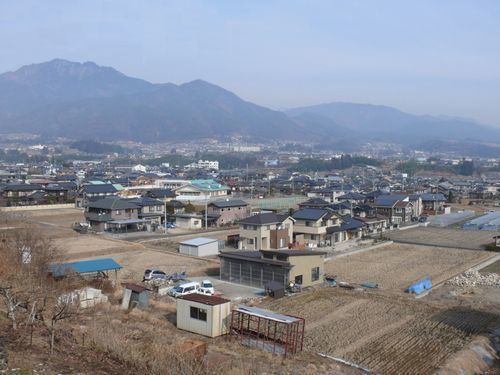Country Japan Region ChubuKoshinetsu | Population 105,335 (2010) Area 658.76 km2 | |
 | ||
Map of Iida, Nagano
Iida (飯田市, Iida-shi) is a city located in southern Nagano Prefecture, in the Chūbu region of Japan. As of 1 October 2016, the city had an estimated population of 101,121 and a population density of 154 persons per km². Its total area was 658.66 square kilometres (254.31 sq mi). Iida is an Environmental model city (環境モデル都市, Kankyō moderu toshi) is a municipality designated by the Japanese government to be a model for making large cuts in greenhouse gas emissions towards the realization of a low-carbon society.
Contents
- Map of Iida Nagano
- Soba iida nagano gourmet report
- A trip to igaya in iida nagano ken
- Geography
- Surrounding municipalities
- Climate
- Demographics
- History
- University
- Primary and secondary education
- Railway
- Highway
- Overseas
- Within Japan
- Culture
- References

Soba iida nagano gourmet report
A trip to igaya in iida nagano ken
Geography

Iida is the southernmost city of Nagano Prefecture. Mount Hijiri at 3,013 metres (9,885 ft) is the highest elevation in the city. Iida lies 90 minutes northeast of the major city of Nagoya by automobile via the Chūō Expressway. The same expressway also provides access to Tokyo, about four hours to the east. The nearest large metropolis to Iida is Nagoya, which is easily accessible by bus (about 2 hours). The larger cities of Matsumoto and Nagano in central and northern Nagano Prefecture are also accessible by bus and train. There is also a bus service to Shinjuku, Tokyo (about 4 hours).
Surrounding municipalities

Climate
Iida has a humid subtropical climate (Köppen climate classification Cfa) with very warm summers and cold winters. Precipitation is significant throughout the year, but is heaviest from April to September.
Demographics
Per Japanese census data, the population Iida has remained constant over the past 40 years
As of 2001, 1,700 persons, 1.5% of the city's population, were Brazilians.
History
The area of present-day Iida was part of ancient Shinano Province. The area was part of the holdings of Iida Domain during the Edo period. The town of Iida was created within Shimoina District with the establishment of the municipalities system on April 1, 1889. It was raised to city status on April 1, 1937. Iida escaped the bombings that damaged many other Japanese cities during World War II; however, most of central Iida was destroyed by a massive fire that swept through the central section of the city two years after the end of the war, in 1947.
On September 30, 1956 the city limits were expanded by annexing the neighboring villages of Zakoji, Matsuo, Tatsuoka, Miho, Igara, Yamamoto and Shimohizakata, followed by Kawaji on March 31, 1961 and by Chiyo, Tatsue, and Kamihizakata on March 31, 1964 and by the town of Kanae on December 1, 1984.
On July 1, 1993 - The town of Kamisato from (Shimoina District) merged into the expanded city of Iida, followed by Kami and Minamishinano on October 1, 2005.
University
Primary and secondary education
Iida has 19 public elementary schools and ten public middle schools. There are four public high schools operated by the Nagano Prefectural Board of Education and one private high school.
Railway
Highway
Overseas
Within Japan
Culture
Since 1979 the city of Iida has hosted the Iida Puppetry Festival, a major event that is the largest of its kind in Japan, with over 200 traditional and contemporary troupes from all over Japan and abroad participating in the annual four-day festival in early August. In 2008 the city hosted a nine-day version of the festival with expanded international participation to celebrate the 30th anniversary of the puppetry festival. Iida's connection to the traditional Japanese puppet theater commonly known as ningyō jōruri or Bunraku goes back more than 300 years. Four traditional puppet troupes are located in or near Iida: the Imada Puppet Troupe, Kuroda Puppet Troupe, the Furuta Puppets, and the Waseda Puppets.
In June, the "Saiwai Shimoina Wadaiko Festival", a major taiko drum festival takes place in Iida. Each year, top drum groups perform at the "Super Show" while amateur groups perform at the "Fringe Festival."
Beginning in July, there are many festivals at local shrines. One aspect of these festivals that surprises visitors is the quantity of fireworks. One of the biggest and most spectacular displays of fireworks is the Tōrō-nagashi festival, in Tokimata, held around the 16th of August. The fireworks are also shot off on the surface of the Tenryu River. Another important festival in Iida is Oneri Matsuri, which is held every seventh year (the last being 2016, the next in March, 2022), a massive four-day event, most famous for the shi-shi lion dance.
Iida has adopted the apple as its symbol. One of the city's largest festivals is the Ringon Matsuri (Apple Festival), held every year in early August, and Iida's Ringo Namiki-dori (a street lined with apple trees) is tended by students of the city's Higashi Middle School. The area around Iida is well known for extensive peach, apple, and persimmon orchards, as well as the production of many other agricultural products, including Asian pears (nashi) and strawberries. A local specialty is hoshi-gaki, or dried persimmons.
Iida is also known for the production of mizuhiki.
